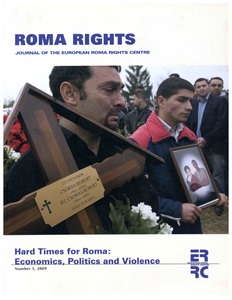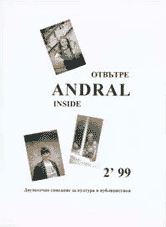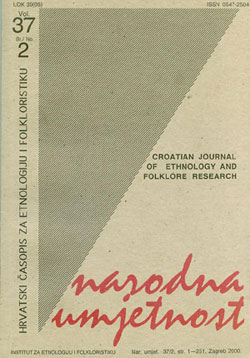
Editors' Blog: Bride Kidnapping Part II
After posting a few weeks ago about the infamous tradition of bride kidnapping, I received a fascinating message from Russell Kleinbach, a professor at Philadelphia University.
More...We kindly inform you that, as long as the subject affiliation of our 300.000+ articles is in progress, you might get unsufficient or no results on your third level or second level search. In this case, please broaden your search criteria.

After posting a few weeks ago about the infamous tradition of bride kidnapping, I received a fascinating message from Russell Kleinbach, a professor at Philadelphia University.
More...
Risky experiments and wacky geography spur a massive review
More...
TI says its index “is not intended to measure a country's progress over time."
More...
At the beginning of 2009, the ERRC held two theme-specific training sessions with the support of United Nations Democracy Fund (UNDEF) in Montenegro attended by participants mainly from the Balkans region. Below is a brief account of both workshops.
More...
IN MEMORIAM: Except for six homes under legal dispute, the final homes in Europe’s oldest Romani settlement, Sulukule of Istanbul, Turkey, were razed to the ground in April and May 2009. Sulukule’s approximately 3,400 impoverished residents, who are overwhelmingly Romani, are now scattered around Istanbul.
More...


The present study aims to investigate the contribution that actor Edward G. Robinson brought to the American film industry, beginning with his iconic role as gangster Little Caesar in Mervyn Le Roy’s 1931 production, and continuing with widely-acclaimed parts in classic film noirs such as Double Indemnity, The Woman in the Window and Scarlet Street. Edward G. Robinson was actually a Romanian Jew, born Emmanuel Goldenberg in Bucharest, in 1893, a relatively little known fact nowadays. By examining his biography, filmography and his best-known, most successful films (mentioned above), I show that Edward G. Robinson was one of classical Hollywood’s most influential actors; for instance, traits of his portrayal of Little Caesar (one of the very first American gangster films) can be found in almost all subsequent cinematic gangster figures, from Scarface to Vito Corleone. In the same vein, the doomed noir characters he played in Fritz Lang’s The Woman in the Window and Scarlet Street are still considered by film critics today to be some of the finest, most nuanced examples of noir heroes. Therefore, the main body of my article will be dedicated to a more detailed analysis of these films, while the introductory section will trace his biography and discuss some of his better-known films, such as Confessions of a Nazi Spy and Key Largo. The present study highlights Edward G. Robinson’s merits and impact on the cinema industry, proving that this diminutive Romanian Jew of humble origins was indeed something of a giant during Hollywood’s classical era.
More...
The article discusses the recent international interest in contemporary Romanian art and its growth in market share, with a focus on the United States. The theme is followed thorough in numerous museum exhibitions, increased collector following, art fair presence, gallery representation and auction activity initially in Europe and the United States. The phenomenon is discussed both in the context of the larger international movement conducive to the contemporary art price bubble, and in that of the local socio-economic changes. My chief interest lies in the factors leading up to the entry of post 1989 Romanian art in the global arena as a manifestation of market forces in the field. The analysis follows its grass roots local emergence through non-profit institutions, individual artists, small publications, low budget galleries, as well as the lack of contribution (with few notable exceptions) of state institutions, while pointing out the national context of increasing deregulation of social support systems resulting in lack of focus on cultural manifestations. The conclusion is that the recent ascent of contemporary Romanian art (and coincidentally, the award winning contemporary Romanian cinematography) is a fortuitous convergence of various factors, among which, increased international mobility and sharing. At the same time, it is also the result of the evolution of various individual artists that pursued a form of art rooted in Romanian artistic tradition but with a focus on the symbolic figurative. The result is a personal semiotics of raising the mundane to extraordinary levels that reconfigured the anxiety of entering a new system into an unmistakable and lasting visual language.
More...
As the main author of the Declaration of Independence and foremost among the Founding Fathers, Thomas Jefferson is one of the easiest recognizable iconic figures in American history. His carved image looms over the monumental Mount Rushmore in the august company of Theodore Roosevelt, George Washington, and Abraham Lincoln. His picture appears on the two-dollar bill (still in circulation but becoming exceedingly rare in what is perhaps another historical irony – Jefferson died at the age of 83 in dire poverty, from a boil in the buttocks). His ubiquitous name still resonates on the façades of numerous high-schools and street signs throughout the entire nation. What is less known though is Jefferson’s keen interest in the Anglo-Saxon roots of the country whose third President he became in 1801. He was an accomplished Anglo-Saxonist, planning to finalize an Old English grammar and to adjust the contemporary language accordingly (mercifully, he never completed the project). He also insisted that Old English be taught in public schools, to replace Greek or Latin that were part of the traditional scholastic curriculum, such as it was at the time. The University of Virginia, an institution that Jefferson patronized and felt particularly connected with, introduced Anglo-Saxon studies following Jefferson’s 1818 Report to its commission.
More...
After years of anti-Semitic and extremist pronouncements from the pulpit, 'Solidarity priest' Henryk Jankowski finally gets the sack.
More...
Women can, and should, play a bigger role in the Bulgarian Orthodox Church. If only we could discuss it.
More...
The paper deals with the question of creation, i.e., writability of the (field) dialogue in an ethnographic text, aiming at the problem of the loud announcement of "the return to the field" as the basic ethnological (anthropological) activity. The silent instruction on the repressing of the majority of the "non-field" problems that, by the way, occupy this discipline in the course of last decades, is not perceived as rescuing. This paper therefore discusses somewhat overused issues of the relationship between the field and the theory, and in the first instance in their curious form, in which they occur after the return from the field. The issue here is the cleft stick between the paradox of the dialogue as the new (writing-totalitarian) paradigm, i.e., serious problems of writing, the textual manageability of the so-called dialogue ethnography on the one hand and what we can call the recent revival of almost untouched imperative of the fieldwork research on the other. This paper does not aim at presenting the audience with any stable solutions. Instead it suggests the repeated discussions not only of the concepts of the dialogue and the field, but also the untouchable ideal of the interdisciplinarity (theoretical competence over the "lower" scholarly strata) that can blur and even falsify the already enough problematic nature of their mutual relations.
More...